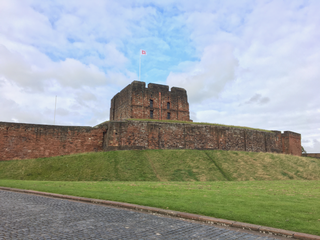 W
WThe Siege of Bridgwater took place in July 1645, during the First English Civil War, when a Royalist garrison surrendered to a Parliamentarian force under Sir Thomas Fairfax.
 W
WThe Bury St Edmunds witch trials were a series of trials conducted intermittently between the years 1599 and 1694 in the town of Bury St Edmunds in Suffolk, England.
 W
WThe Crown and Treaty is a pub on Oxford Road in Uxbridge, London, England, where Charles I and his Parliamentary opponents during the English Civil War held negotiations between 30 January and 22 February 1645. It is a Grade II* listed, dating from 1576.
 W
WThe Great Siege of Scarborough Castle was a major conflict for control of one of England's most important stone fortresses during the First English Civil War fought between the Parliamentarians and the Royalists loyal to King Charles I. In February 1645, Parliamentarians laid siege to Scarborough Castle. For five months, they bombarded it, destroying most of the keep, and engaged in bloody fighting before the defenders finally surrendered.
 W
WThe Battle of Langport was a Parliamentarian victory late in the First English Civil War which destroyed the last Royalist field army and gave Parliament control of the West of England, which had hitherto been a major source of manpower, raw materials and imports for the Royalists. The battle took place on 10 July 1645 near the small town of Langport, which lies south of Bristol.
 W
WThe Battle of Naseby was a decisive engagement of the First English Civil War, fought on 14 June 1645 between the main Royalist army of King Charles I and the Parliamentarian New Model Army, commanded by Sir Thomas Fairfax and Oliver Cromwell. It was fought near the village of Naseby in Northamptonshire.
 W
WThe Oxford Parliament was the Parliament assembled by King Charles I for the first time on 22 January 1644 and adjourned for the last time on 10 March 1645, with the purpose of being an instrument of the Royalist war campaign.
 W
WThe Siege of Oxford refers to the English Civil War military campaigns waged to besiege the Royalist controlled city of Oxford, involving three short engagements over twenty-five months, which ended with a Parliamentarian victory in June 1646.
 W
WThe Battle of Rowton Heath, also known as the Battle of Rowton Moor, occurred on 24 September 1645 during the English Civil War. Fought by the Parliamentarians, commanded by Sydnam Poyntz, and the Royalists under the personal command of King Charles I, it was a significant defeat for the Royalists, with heavy losses and Charles prevented from relieving the Siege of Chester.
 W
WThe Self-denying Ordinance was passed by the English Parliament on 3 April 1645. All members of the House of Commons or Lords who were also officers in the Parliamentary army or navy were required to resign one or the other, within 40 days from 3 April 1645.
 W
WThe Second Siege of Bristol of the First English Civil War lasted from 23 August 1645 until 10 September 1645, when the Royalist commander Prince Rupert surrendered the city that he had captured from the Parliamentarians on 26 July 1643. The commander of the Parliamentarian New Model Army forces besieging Bristol was Lord Fairfax.
 W
WThe Siege of Carlisle occurred during the First English Civil War when the allied forces of the Scottish Covenanters and the English Parliamentarians besieged Carlisle Castle which was held at the time by the English Royalist forces loyal to King Charles I. The siege took place in Carlisle, Cumbria from October 1644 to 25 June 1645.
 W
WThe Siege of Chester occurred over a 16 month period between September 1644 and February 1646 during the First English Civil War. In the engagement, Sir William Brereton and the Parliamentarians were ultimately successful in taking possession of the city and Royalist garrison commanded by Lord Byron.
 W
WThe sieges of Taunton were a series of three blockades during the First English Civil War. The town of Taunton, in Somerset, was considered to be of strategic importance because it controlled the main road from Bristol to Devon and Cornwall. Robert Blake commanded the town's Parliamentarian defences during all three sieges, from September 1644 to July 1645.
 W
WThe Siege of Tiverton took place in October 1645 during the First English Civil War, when a Royalist garrison surrendered to a detachment of the New Model Army.
 W
WThe Battle of Weymouth and the associated Crabchurch Conspiracy occurred in 1645, during the First English Civil War, when several royalist plotters within the twin towns of Weymouth and Melcombe on the Dorset coast conspired to deliver the ports back into the control of King Charles I.